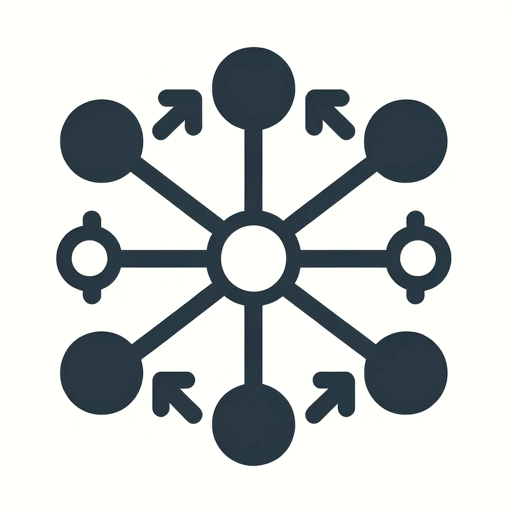Graph Theory-Graph Theory Analysis Tool
AI-powered Graph Theory Analysis and Visualization
How can I apply Graph Theory to my project?
Explain Graph Theory in the context of network analysis.
Generate a graph that represents a social network.
Find real-life applications of Graph Theory in logistics.
Related Tools
Load More
Graph Maker
This GPT can provide guidance on the most appropriate type of graph for different data sets, such as bar charts, line graphs, pie charts, scatter plots, and more.

Dr. Graph
Expert at creating accurate graphs with researched data

Graph Maker
Specialist in creating diagrams and graphs based on user requests

Graph Analyzer
Expert in analyzing graphs from any field.

Topology
Expert in mathematical topology and geometry, offering precise explanations.

FlowGPT
Propagation Analysis over Graphs
20.0 / 5 (200 votes)
Introduction to Graph Theory
Graph theory is a branch of mathematics focusing on the study of graphs, which are mathematical structures used to model pairwise relations between objects. A graph is made up of vertices (also called nodes) and edges (the connections between nodes). Graph theory's primary functions include understanding how entities are interconnected, finding the shortest path between nodes, and detecting clusters within networks. For instance, in social networks, vertices represent people and edges represent friendships. Understanding these relationships helps in analyzing social influence, information spread, and community detection. Another example is in transportation, where cities are vertices and roads are edges, and graph theory helps in optimizing routes and reducing travel time.

Main Functions of Graph Theory
Pathfinding and Shortest Path Algorithms
Example
Dijkstra's algorithm, A* algorithm
Scenario
In GPS navigation systems, algorithms like Dijkstra's are used to find the shortest path between two locations. For example, when driving from point A to point B, the GPS uses these algorithms to provide the most efficient route, considering various factors such as distance and traffic conditions.
Network Flow Analysis
Example
Max-flow min-cut theorem, Ford-Fulkerson algorithm
Scenario
In supply chain logistics, network flow analysis helps determine the maximum possible flow of goods from suppliers to consumers through a network of warehouses and transport routes. This ensures that supply meets demand efficiently, minimizing bottlenecks and optimizing resource allocation.
Graph Coloring and Scheduling
Example
Greedy coloring algorithm, chromatic number
Scenario
In task scheduling, graph coloring is used to assign resources (like time slots or processors) to tasks without conflicts. For instance, in exam scheduling for a university, the goal is to schedule exams in such a way that no student has overlapping exams. Each exam is a vertex, and an edge represents a common student. Coloring the graph ensures a conflict-free schedule.
Ideal Users of Graph Theory
Researchers and Academics
Researchers and academics use graph theory to explore theoretical aspects of networks and solve complex problems in various fields like biology, computer science, and social sciences. For example, in biology, graph theory models the interaction between proteins and genes, helping to understand cellular processes and disease mechanisms.
Industry Professionals
Professionals in fields such as telecommunications, logistics, and information technology leverage graph theory for practical applications. Telecommunication companies use graph theory to optimize network design and routing protocols, ensuring efficient and reliable communication services. Similarly, IT professionals use it to design algorithms for data analysis, cybersecurity, and software engineering.

Guidelines for Using Graph Theory
Step 1
Visit aichatonline.org for a free trial without login, also no need for ChatGPT Plus.
Step 2
Familiarize yourself with basic graph theory concepts such as vertices, edges, and common types of graphs.
Step 3
Identify the specific problem or project where graph theory can be applied, such as network analysis, algorithm design, or data visualization.
Step 4
Utilize graph theory tools and software for modeling and analysis, like NetworkX for Python or Gephi for visualization.
Step 5
Analyze the results and apply insights gained from graph theory to optimize or understand the problem better. Review and iterate as necessary.
Try other advanced and practical GPTs
Romance Novel Crafter
Craft captivating romance with AI

git hivemind
AI-powered Git management made easy

GlucoseTracker
AI-powered tool for glucose stability

Steamy Stories Generator
AI-Powered Personalized Narrative Creator

STAGE AI
AI-driven platform for creators and designers

한국 기독교 교회 최신 뉴스 - 성경 목회 (Christianity Church)
AI-powered Christian news and insights

Music Theory
AI-powered music theory insights

Theory of Computation
AI-powered computational theory assistant.

Algebraic Number Theory GPT
AI-powered tool for algebraic number theory solutions.

Game Theory
AI-powered tool for strategic analysis.

DnD Magic Item Generator
AI-powered Magic Item Generator for D&D

Meeting Summary and Action Item Specialist
AI-powered tool for summarizing meetings and identifying action items.

- Data Visualization
- Algorithm Design
- Network Analysis
- Social Networks
- Optimization Problems
Graph Theory Q&A
What is graph theory?
Graph theory is a field of mathematics that studies the properties and applications of graphs, which are structures made up of vertices (nodes) connected by edges (links).
How can graph theory be applied in computer science?
In computer science, graph theory is used in algorithm design, network topology, database design, and more. It helps in solving problems related to connectivity, data organization, and resource optimization.
What are some common types of graphs?
Common types of graphs include undirected graphs, directed graphs, weighted graphs, trees, and bipartite graphs. Each type has specific properties and uses.
Which tools are recommended for graph theory analysis?
Popular tools include NetworkX (Python library for graph analysis), Gephi (open-source network visualization tool), and Cytoscape (software for visualizing complex networks).
What are real-world applications of graph theory?
Graph theory is applied in various fields such as social network analysis, biology (gene network mapping), transportation (route optimization), and communication networks (data flow analysis).